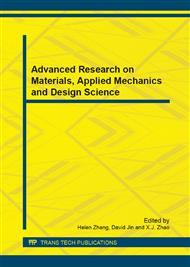[1]
J. D. Lee, H. S. Kim, S. Y. Jeong, K. H. Kim, J. J. Lee, J. E. Kim, Curr. Appl. Phys. Vol. 10 (2010), p.249.
Google Scholar
[2]
Y. P Lee, K. W. Kim, R. Gontarz, Y. V. Kudryavtsev, Curr. Appl. Phys. Vol. 16 (2001), p.451.
Google Scholar
[3]
Z. B. Yu, M. H. Qiao, H. X. Li, J. F. Deng, Appl. Cata. Vol. 163 (1997), p.1.
Google Scholar
[4]
W. Maziarz, J. Alloys Compd. Vol. 448 (2008), p, 223.
Google Scholar
[5]
P. N. Zhang, J. Liu, J. Alloys Compd. Vol. 462 (2008), p.225.
Google Scholar
[6]
L. Shi, C. F. Sun, P. Gao, F. Zhou, W. M. Liu, Appl. Surf. Sci. Vol. 252 (2006), p.3591.
Google Scholar
[7]
A. Ghahremaninezhada, A. Dolati, J. Alloys Compd. Vol. 480 (2009), p.275.
Google Scholar
[8]
B. N. Mondal, A. Basumallick, P. P. Chattopadhyay, J. Alloys Compd. Vol. 457 (2008), p.10.
Google Scholar
[9]
L. Aymard, B. Dumont, G. Viau, J. Alloys Compd. Vol. 242 (1996), p.108.
Google Scholar
[10]
P. Díaz-Arista, Z. I. Ortiz, H. Ruiz, R. Ortega, Y. Meas, G. Trejo, Surf. Coat. Tech. Vol. 203 (2009), p.1167.
Google Scholar
[11]
Z. F. Lodhi, J. M. C. Mol, W. J. Hamer, H. A. Terryn, J. H. W. DeWit, Electrochim. Acta. Vol. 52 (2007), p.5444.
Google Scholar
[12]
E. Beltowska-Lehman, Surf. Coat. Tech. Vol. 151–152 (2002), p.440.
Google Scholar
[13]
E. Beltowska-Lehman, P. Ozga, Z. Swiatek, Surf. Coat. Tech. Vol. 151–152 (2002), p.444.
Google Scholar
[14]
Sun Kyu Kim, Hong Jae Yoo, Surf. Coat. Tech. Vol. 108 –109 (1998), p.564.
Google Scholar
[15]
C. Guo, Y. Zuo, X. H. Zhao, J. M. Zhao, J. P. Xiong, Surf. Coat. Tech. Vol. 202 (2008), p, 3246.
Google Scholar
[16]
Y. J. Xue, X. Z. Jia, Y. W. Zhou, W. Ma, J. S. Li, Surf. Coat. Tech. Vol. 200 (2006), p, 5677.
Google Scholar
[17]
B. S. Li, A. Lin, X. Wu, Y. M. Zhang, F. X. Gan, J. Alloy. Compd. Vol. 453 (2008), p, 93.
Google Scholar
[18]
T. Nickchi, M. Ghorbani, Surf. Coat. Tech. Vol. 203 (2009), p.3037.
Google Scholar
[19]
M. M. Kamel, J. Appl. Electrochem, Vol. 37 (2007), p.483.
Google Scholar
[20]
A. Bai, C. C. Hu, Electrochim. Acta, Vol. 47 (2002), p.3447.
Google Scholar
[21]
C. L. Fan, D. L. Piron, Electrochim. Acta, 41 (1996) 1713.
Google Scholar


